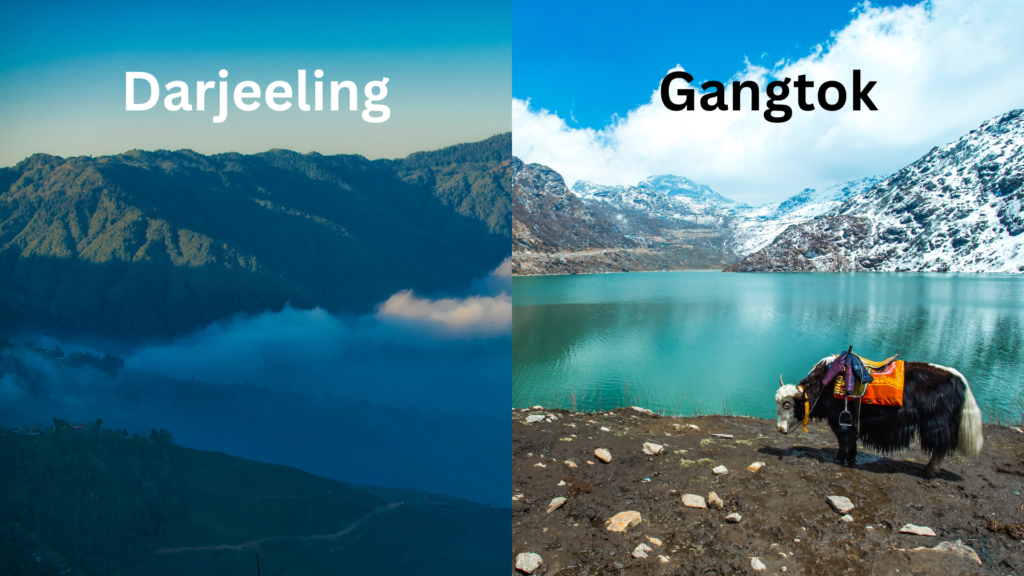
Best time to visit Darjeeling and Gangtok with family offer the perfect backdrop for unforgettable family adventures. Picking the right time to visit means the difference between rain-soaked socks and sunlit strolls among tea gardens.
Pack your bags for a trip that will fill your albums and hearts with joy, because these hill towns know how to leave a mark!
Weather in Darjeeling and Gangtok Throughout the Year
Darjeeling and Gangtok enjoy crisp mountain air, but the weather can change quickly. Summers bring rain, while winters add a nip to the air. Spring and autumn shine with mild temperatures and clear views. For families, the right season means safe roads, outdoor play, and comfortable sleep at night.
- Spring: 8°C to 18°C, mild and breezy.
- Summer: 13°C to 19°C, heavy rainfall, lush green valleys.
- Autumn: 8°C to 17°C, clear skies, perfect visibility.
- Winter: 2°C to 10°C, occasional snowfall, cozy fireside evenings.
Best Time to Visit Darjeeling and Gagntok With Family
Every season adds a new twist to Darjeeling and Gangtok. Some seasons bring color and crowds, while others offer peace and solitude. Here’s what families can look forward to as the months roll by.
Spring (March to May)
Darjeeling and Gangtok in spring feel like a scene from a storybook. Rhododendrons and magnolias bloom everywhere. Crisp mornings give way to sunny afternoons, perfect for family walks.
- Views of snow-capped peaks
- Botanical gardens in full bloom
- Children’s parks come alive
- Activities: toy train rides, heritage walks, and ropeway trips.
Summer (June to August)
Monsoon season paints the region emerald green but packs the sky with heavy clouds. Rain falls often, making some roads slippery. Families who like quiet escapes will find these towns peaceful, with fewer tourists.
- Pros: Misty valleys and waterfalls are at their best and offer affordable stays.
- Cons: Landslides are possible, and some attractions may close.
- Kids can jump in puddles, enjoy indoor play zones, and sip hot chocolate.
Autumn (September to November)
Autumn sweeps away the rain, leaving blue skies and crisp air. The landscape glows with golden light, perfect for family photos. This is prime sightseeing season.
- Best visibility of the Himalayas
- Local festivals fill the streets
- Parks and gardens offer picnics and open play
- Attraction queues are manageable
Winter (December to February)
Chilly, quiet, and sometimes dusted with fresh snow, winter invites families who love a bit of adventure. Woollen hats, steaming tea, and short days create cozy memories.
- Snow play at higher spots
- Winter carnivals and fairs
- Sipping Darjeeling tea by the fire
- Pack extra layers for little ones!
Events and Festivals: Creating Special Family Memories
Festivals in the hills feel personal and warm. They sweep you up in song, dance, and colour.
- Darjeeling Tea and Tourism Festival (November): Taste tea, see parades, and join heritage walks.
- Gangtok’s Losoong Festival (December): Mark the Sikkimese New Year with traditional dances and games.
- Spring Flower Shows: Bright blooms, local crafts, and outdoor picnics.
Joining a festival adds sparkle to your trip and gives kids stories to tell for years.
Tips for a Smooth Family Trip for Gangtok and Darjeeling
Your family’s comfort and fun come first!
- Book hotels early during spring and autumn for the best rooms.
- Pack layers: Weather changes quickly. Bring jackets, raincoats, and sun hats.
- Choose family-friendly stays with open play areas and in-house dining.
- Prioritise sightseeing with kids: Pick the toy train, cable car rides, and parks. Save museums for rainy afternoons.
- Carry medication for motion sickness and altitude.
- Travel light but bright—more room for souvenirs!
Plan for Joy: Darjeeling and Gangtok Await
The best time to visit Darjeeling and Gangtok with family depends on the right season. Whether it’s the spring blooms, peaceful monsoon mists, autumn festivals, or winter’s snowy chill, Darjeeling and Gangtok are ready to welcome you. Pick your favourite months, look for those special events, and prepare for laughter echoing in the hills.
